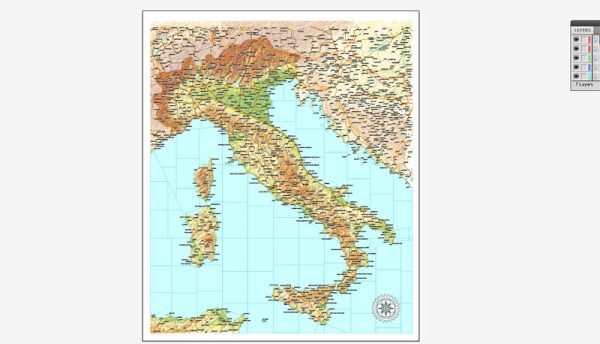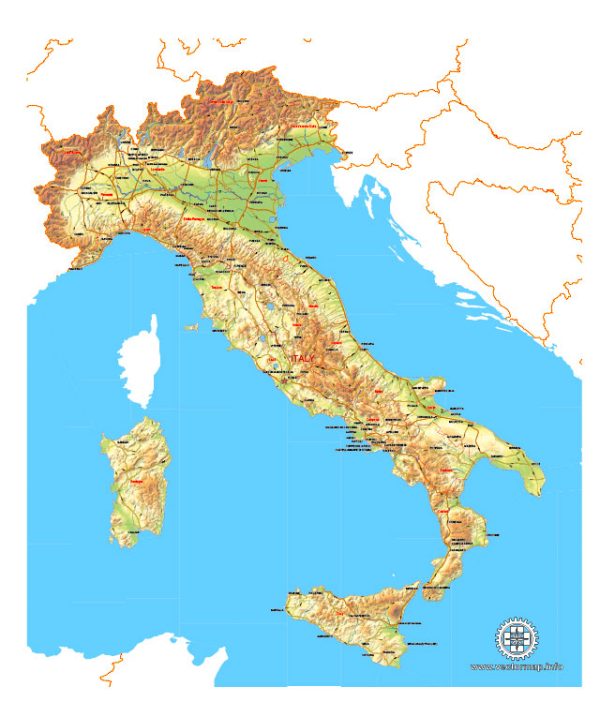Italy has a rich history that spans thousands of years, and its transportation infrastructure has evolved significantly over time.
Vectormap.Net provide you with the most accurate and up-to-date vector maps in Adobe Illustrator, PDF and other formats, designed for editing and printing. Please read the vector map descriptions carefully.
Here’s a detailed overview:
History:
Ancient Rome:
Italy’s history is often traced back to ancient Rome, which emerged as a powerful civilization around 509 BCE. The Romans developed an extensive network of roads, known as the Roman Roads or Viae, to facilitate military and economic movement across the vast empire. These roads were a crucial part of Roman infrastructure, connecting major cities and regions.
Middle Ages and Renaissance:
During the Middle Ages, Italy was divided into various city-states, each with its own ruling elite. Trade flourished between these city-states, and maritime transportation became vital. The Italian Renaissance (14th to 17th centuries) marked a period of cultural, artistic, and economic growth, influencing the development of Italy’s urban centers.
Unification:
In the 19th century, Italy went through a process of unification, known as the Risorgimento, culminating in 1861. This led to the creation of the Kingdom of Italy under King Victor Emmanuel II. The unification process contributed to the development of a more centralized infrastructure system.
20th Century:
In the early 20th century, Italy faced economic challenges and political changes. The rise of Fascism under Benito Mussolini in the 1920s brought about a push for modernization and infrastructural development. The regime aimed to strengthen transportation networks to enhance economic and military capabilities.
Transportation Infrastructure:
Roads:
Italy’s road network is extensive and well-developed. The legacy of Roman roads influenced the modern system. The Autostrade, or highways, connect major cities and regions. Notable roads include the A1 (Autostrada del Sole) connecting Milan to Naples, and the A4 connecting Milan to Venice.
Railways:
Italy has a sophisticated railway network managed by Ferrovie dello Stato Italiane (Italian State Railways). High-speed rail services, such as the Frecciarossa, connect major cities like Rome, Milan, Naples, and Florence, making train travel a popular and efficient option.
Airports:
Italy has numerous international and domestic airports. Rome’s Leonardo da Vinci-Fiumicino Airport and Milan’s Malpensa Airport are among the busiest. The aviation infrastructure has played a crucial role in connecting Italy to the rest of the world.
Ports:
Italy’s extensive coastline and historical maritime influence have led to the development of significant ports. Genoa, Naples, and Trieste are major ports handling both passenger and cargo traffic. The country is well-connected to international shipping routes.
Public Transport:
Italian cities have efficient public transportation systems, including buses, trams, and metro services. Cities like Rome and Milan have extensive metro networks, facilitating intra-city travel.
Challenges and Modern Developments:
Italy faces challenges like traffic congestion, especially in major cities, and the need for ongoing maintenance and upgrades to infrastructure. Efforts have been made to enhance sustainability, promote public transport, and integrate new technologies for smarter mobility solutions.
Italy’s history and transportation infrastructure showcase a blend of ancient heritage and modern advancements, reflecting the nation’s cultural and economic evolution over the centuries.



 Author: Kirill Shrayber, Ph.D.
Author: Kirill Shrayber, Ph.D.